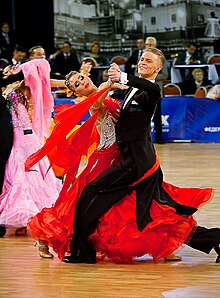International standard waltz

Waltz is one of the five dances in the Standard (or Modern) category of the International Style ballroom dances. It was previously referred to as Slow Waltz or English Waltz.
Waltz is usually the first dance in the Dancesport competition rounds. It is danced exclusively in the closed position, unlike its American Style counterpart.
History
The Waltz originated as a folk dance from Austria. Predecessors include the "Matenick" and a variation called the "Furiant" that were performed during rural festivals in Bohemia. The French dance, "Walt", and the Austrian Ländler are the most similar to the waltz among its predecessors.
The "king of dances" acquired different national traits in different countries. Thus there appeared the English Waltz, the Hungarian Waltz, and the Waltz-Mazurka. The "Waltz" is derived from the old German word "walzen" meaning "to roll, turn", or "to glide". Waltz was danced competitively since 1923 or 1924.
Music
International Standard Waltz is a Waltz dance and danced to slow waltz music, preferably 28-30 bars per minute (84-90 beats per minute).[1] [2] Waltz music is in 3/4 time and the 1st beat of a measure is strongly accented.[3]
Character
Like all Standard category dances, Waltz is a progressive dance, meaning that dancers travel along a path known as the line of dance. It is characterized by pendulum swing movements and incorporates general elements of ballroom technique such as foot parallelism, rise and fall, contra body movement and sway.
Most of the basic figures[clarify] have one step per beat (three per measure), whereas advanced figures[clarify] have four to six steps per measure. The faster pace of the advanced figures, especially when combined with dance turns, results in fast-paced, dynamic dancing despite the relatively slow music tempo. Slow steps and elegant poses are often used to contrast fast-paced dance segments, resulting in what is sometimes referred to as light and shade.
Syllabus
This is the ISTD International Standard syllabus.[4]
Pre-Bronze
Note that Pre-Bronze is included as part of the Bronze syllabus.[5]
Bronze
Silver
- Weave from PP
- Closed Telemark
- Open Telemark and Cross Hesitation
- Open Telemark and Wing
- Open Impetus and Cross Hesitation
- Open Impetus and Wing
- Outside Spin
- Turning Lock
xx. Drag Hesitation
Gold
xx. Fallaway Whisk
See also
References
- ^ http://www.worlddancesport.org/doc/competition/rules%20and%20bidding/2010/IDSF_Competition_Rules_2010-1.pdf
- ^ WDC Competition Rules
- ^ BallroomDancers.com
- ^ The Ballroom Technique; Moore, Alex (2006). Published by ISTD ASIN: B000PH46KI.
- ^ International Standard Syllabus
